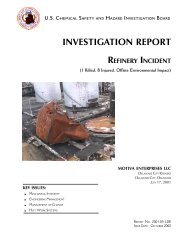CTA Report, Draft 1, ISP Review - US Chemical Safety and Hazard ...
CTA Report, Draft 1, ISP Review - US Chemical Safety and Hazard ...
CTA Report, Draft 1, ISP Review - US Chemical Safety and Hazard ...
You also want an ePaper? Increase the reach of your titles
YUMPU automatically turns print PDFs into web optimized ePapers that Google loves.
4.1.2 Mat-former <strong>and</strong> Baghouse<br />
In the mat-former, air-suction dispersed the phenolic resin powder throughout the web to create a resin-<br />
impregnated fiberglass mat. The suction air—along with excess resin powder <strong>and</strong> smaller fiberglass<br />
fibers—traveled from the mat-former via four vertical air ducts to a baghouse, which was located on the<br />
plant’s roof. Fire dampers <strong>and</strong> manually actuated water sprinklers were located in the vertical ducts.<br />
The pulse-jet baghouse, designed with a capacity of 40,000 cubic feet per minute, was a large rectangular<br />
metal box with a series of long cloth bags hung inside. This baghouse was fitted with an explosion vent.<br />
In addition to providing suction for the mat-former, it also served as a pollution control device. The<br />
baghouse was designed to remove small fiberglass fibers <strong>and</strong> phenolic resin powder with 99 percent<br />
efficiency. Particulate-laden air entered on one side of the baghouse <strong>and</strong> passed through the bags, which<br />
acted like filters to remove fibers <strong>and</strong> resin dust. During this process, a dust cake formed on the exterior<br />
of the bags.<br />
The difference in pressure between the dirty <strong>and</strong> clean sides of the baghouse determined the amount of<br />
suction generated in the mat-former. A gauge mounted in the blend room measured the pressure in inches<br />
of water. 7 Written procedures required that the line be shut down <strong>and</strong> the baghouse cleaned if the<br />
pressure gauge reading was above 6 inches, an amount recommended by the manufacturer. The pressure<br />
drop across the baghouse was recorded in a log twice a day to meet a requirement of the plant’s air quality<br />
permit.<br />
Operators reported that when the bags clogged, an excessive amount of dust blew out of the base of the<br />
mat-former <strong>and</strong> into the plant. To keep the baghouse functioning efficiently, <strong>CTA</strong> used two methods to<br />
periodically clean the bags.<br />
7 An “inch of water” is a unit of pressure equal to the pressure exerted by a column of liquid water 1 inch high at a<br />
st<strong>and</strong>ard temperature. One inch of water equals 0.0361 pound per square inch (psi).<br />
25









